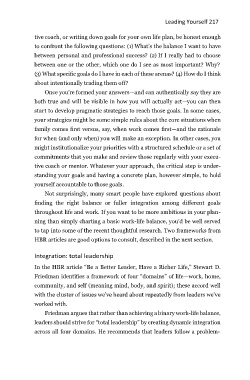Page 228 - HBR Leader's Handbook: Make an Impact, Inspire Your Organization, and Get to the Next Level
P. 228
Leading Yourself 217
tive coach, or writing down goals for your own life plan, be honest enough
to confront the following questions: (1) What’s the balance I want to have
between personal and professional success? (2) If I really had to choose
between one or the other, which one do I see as most important? Why?
(3) What specific goals do I have in each of these arenas? (4) How do I think
about intentionally trading them off?
Once you’re formed your answers—and can authentically say they are
both true and will be visible in how you will actually act—you can then
start to develop pragmatic strategies to reach those goals. In some cases,
your strategies might be some simple rules about the core situations when
family comes first versus, say, when work comes first—and the rationale
for when (and only when) you will make an exception. In other cases, you
might institutionalize your priorities with a structured schedule or a set of
commitments that you make and review those regularly with your execu-
tive coach or mentor. Whatever your approach, the critical step is under-
standing your goals and having a concrete plan, however simple, to hold
yourself accountable to those goals.
Not surprisingly, many smart people have explored questions about
finding the right balance or fuller integration among different goals
throughout life and work. If you want to be more ambitious in your plan-
ning than simply charting a basic work-life balance, you’d be well served
to tap into some of the recent thoughtful research. Two frameworks from
HBR articles are good options to consult, described in the next section.
Integration: total leadership
In the HBR article “Be a Better Leader, Have a Richer Life,” Stewart D.
Friedman identifies a framework of four “domains” of life—work, home,
community, and self (meaning mind, body, and spirit); these accord well
with the cluster of issues we’ve heard about repeatedly from leaders we’ve
worked with.
Friedman argues that rather than achieving a binary work-life balance,
leaders should strive for “total leadership” by creating dynamic integration
across all four domains. He recommends that leaders follow a problem-

